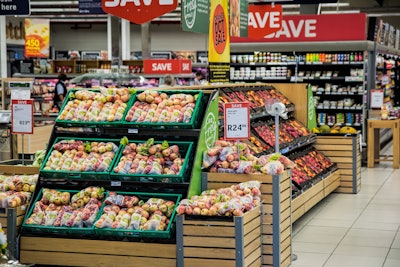
Most US State governments have ordered restaurants to close their dine-in rooms in response to the spread of Coronavirus disease (COVID-19) throughout the country. Added to that, school closures, event and conference cancellations, increased telecommuting, and reduced travel have shrunk foodservice activity, limiting food away from home to only takeout and delivery ordering, for an unknown period.
With so many Americans staying home, demand for home consumption items has suddenly surged, and food availability in the retail channel has become a concern for consumers, authorities, food processors, and retailers. Sales performance data indicates a surge in staple and shelf-stable item sales in March, when authorities started announcing shutdown measures in most of the country. Traditional items, such as pasta, baking ingredients, and long-lasting dairy items, were back on consumers’ shopping lists, as consumers engaged in stockpiling to face the increased time at home and to prepare for eventual lockdowns and reduced visits to grocery stores.
Rabobank estimates that every 10% drop in out-of-home food spending (e.g. restaurants, cafes, cafeterias, etc.) translates into approximately an additional 3% in retail food spending. This estimate seeks to provide food players and grocery stores a sense of the magnitude of the challenge we face in feeding a population that – from one day to the next – was told to stay at home.
This scenario brings to food industry players the challenge of increasing retail supply amid a virus pandemic. The logical first step is to maximize production running rates, but converting foodservice lines and portfolios into retail also becomes a way to access fresh supply and support foodservice providers affected by the abrupt closures.
Unprecedented Operational Challenges, by Sector
To a limited extent, foodservice production has already been converted to retail sizes, brands, and specifications. It is a less problematic task for players that supply both segments, although dedicated lines and availability of retail-size packaging and labels may represent a constraint.
However, there are specific challenges to take into account, which vary by sector. In this note, we intend to outline, sector by sector, the actions that are being taken and the challenges players are facing to divert supplies from foodservice to retail channels.
Animal Protein
- Beef and chicken were initially heavily impacted by the slowdown in foodservice, but were largely redistributed through the retail channel. Pork is less exposed to the foodservice channel,with the exception of bacon.
- After the initial surge in retail led by consumers stockpiling, we are now seeing markets stabilize and move lower. Consumers’ ability to pay is, in many cases, limited due to rising unemployment and market uncertainty. This has a greater impact on high-cost items and meat products that are more difficult to prepare.
- Meat companies are reducing specialty and further value-added processing in favor of low-cost commodity items to fulfill retail demand. We do not foresee plants reverting to previous items until markets stabilize.
- Chicken wings have been challenged by the slowdown in sporting events and foodservice. Other products with heavy foodservice exposure include bellies, tenders, and grinds. Most of these products are being redirected to retail with varying levels of success.
- Employee absenteeism at plants has increased, and there have been a few individual cases of the virus at plants, which have been managed. New procedures to screen employees were implemented, adding costs and slowing lines.
- We are seeing some foodservice and distribution employees being redeployed in the packing and retail sectors. Ultimately, rising unemployment in the US may ease the labor constraints in the packing industry.
- Product distribution has not seen any major disruptions from the concessions made on driver hours. Freight rates have increased marginally but are stabilizing.
Baked Goods
- Bakeries have benefited from increased demand for fresh items in the retail segment. Fresh bakery players, who are well-positioned to pivot production to their retail portfolio, are looking to hire over 3,000 employees to start immediately. As baked items have a short shelf life, sales of baking ingredients, such as flour and yeast, have surged significantly (+17% and +52%,respectively, in the first week of March, according to IRI), indicating home baking could absorb some of the extra demand.
- Of the three major packaged-bread manufacturers in the country, only two have exposure to foodservice. Within foodservice bakery, the main clients are quick-service restaurants (QSR),which are expected to be less affected due to their drive-thru structures (takeout), lower average ticket, and client age profile.
- Pure foodservice players, usually in the frozen bakery segment, will be affected the most.Around 76% of foodservice baked goods consumption is sourced from the frozen segment, a USD 12bn business. In retail, the only possible alternative outlet is grocery stores’ in-store bakeries, but to a much smaller extent since this segment accounts for only USD 5bn in frozen intake, and stockpiling has made visits to grocery stores less frequent.
Beverages
- Roughly 15% to 25% of beverage volume goes through the on-premise foodservice channels.
- Alcohol represents 29% of restaurant and bar revenues nationwide (excluding limited-service restaurants), according to data provided by Technomic. The on-premise channel sells about USD 10bn of alcohol per month. That is expected to all but disappear during the ban on on-site dining and drinking.
- As foot traffic falls and the number of visitors approaches zero, coffee shops and taproom-focused craft brewers, wineries, and craft distillers reliant on tasting rooms will also face significant challenges, as their ability to shift volume off-premise may be limited.
- Off-premise sales are growing significantly (thus far sustained at levels over 50% YOY) as consumers stock up. Large packages, comfort brands, and big-box and e-commerce channels are doing particularly well.
Dairy
- The initial impact of the coronavirus outbreak on the US dairy sector has been a robust retail pull for dairy products across the entire product range. The surge in demand for products ranging from fresh milk to canned milk and from processed cheese to ice cream has resulted in supply chain challenges that have largely been met.
- In the short term, the strength in retail demand has offset and absorbed seasonally rising milk production and excess product from slowing foodservice and export demand. In some cases,manufacturers servicing the foodservice market have pivoted to providing products to the retail chain.
- By mid-second quarter, if not earlier, the sector will face the logistical and economic challenges of excess milk and commodity dairy products. The surge in retail demand is forecast to subside and no longer offset declining foodservice and export demand. Approximately 40% of total cheese production is used in foodservice (about 440m pounds each month), and over 65% of nonfat dry milk powder is exported (about 125m pounds per month). Even if adequate warehouse space is found, the sector will be challenged to finance the inventory without government assistance.
- Liquidity issues are already being raised, as restaurants are unable to pay distributors, and distributors are unable to pay manufacturers. Within the Federal Milk Marketing Orders,manufacturers are required to pay dairy farmers twice a month for their milk deliveries. As a result, some dairy cooperatives are encouraging their members to voluntarily reduce milk production. Their second request is likely to be mandatory.
Fruits & Vegetables
- Roughly 85% of fresh fruit and 65% of fresh vegetables are normally consumed at home. Due to the surge in retail food demand, that part of the chain is absorbing the smaller portion that would have gone to foodservice.
- Given its perishability, many fresh produce items are typically delivered daily to both retail and restaurants, and the value chain cannot sit on large inventories. This allows the fresh produce industry to make adjustments in distribution very rapidly.
- The potential bottleneck is in logistics. Some trucking fleets and independents are geared toward foodservice, while others are geared to retail. There had been a shortage in trucks and drivers needed to service retail, while other drivers were looking for work due to the drop-off in foodservice. Produce companies and retailers that manage their own fleets have been in a better competitive situation. The logistics industry has rapidly made the necessary adjustments to fix the imbalance.
- A different situation exists for frozen potatoes, since 85% of consumption occurs in the foodservice channel, mostly in the QSR segment. The increase in retail frozen potato sales will not be enough to offset lost foodservice sales, so hopes are pinned on a lower disruption in QSR restaurants through increased deliveries and takeout. Weather-driven tightness in supply has been supportive of potato prices and farming profitability in the current season, but the drop-off in foodservice demand will ease the supply-demand imbalance. For potato processors,frozen dependence on foodservice is expected to result in negative financial impacts in the short run. In the medium and long terms, the likely economic slowdown should be supportive of strong QSR sales of frozen potatoes, as consumers trade full-service restaurant visits for lower-cost alternatives.
A Tale of Two Channels
The initial stockpiling stage that led to empty shelves and lines at grocery shops’ doors seems to be behind us. Consumers have adapted to new shopping routines and added stocks to their fridges and pantries. Food companies and retailers have accepted the challenge to keep running and make more food available for consumers during the unfolding crisis. On the production side, there are no signals of a major disruption in the production chain other than isolated cases.
This is an unprecedented and uncertain environment for all. Challenges and opportunities vary by sector, product, and company. In all sectors analyzed above, however, flexibility in production and a diversified client base remain common key assets for companies to navigate through the demand dislocation.
In this environment, players with high exposure to foodservice are the ones to feel more pressure. Exploring supply gaps in the retail channel remains as an opportunity to offset – at least partially – revenue losses from foodservice. However, pressure may still be felt, as some products are mostly consumed outside the home, such as prime meat cuts, seafood, difficult-to-prepare dishes, and frozen baked goods, and don’t translate into retail in a one-to-one conversion. In addition, some players may face limited availability of retail-size packaging, different specifications, and distribution constraints, as well as working capital restrictions during these turbulent times.
Given the dynamism of the current crisis, we will continue to provide updates on the current state of the food supply chain as new data comes out. Looking forward, we will work to forecast key shifts in consumer behavior, potential new or fading trends, and corporate strategy reviews in the pandemic aftermath, also taking into account the likely deterioration of the economic landscape.
















